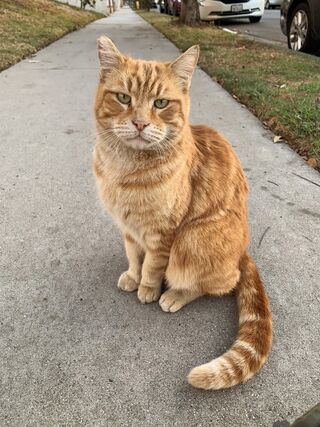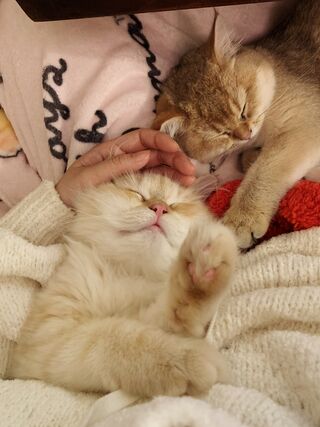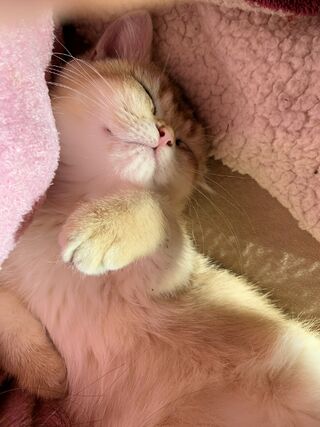Animal Behavior
8 Reasons Your Cat Will Always Be Your "Baby"
Neotenous features, "biscuit-making," and more.
Posted December 27, 2021 Reviewed by Lybi Ma
Key points
- Cat owners often see their cats as their babies, despite their independent nature.
- Indeed, many features of cats mimic those of human babies, eliciting a strong care-taking desire due to evolutionary forces.
- Care-taking behaviors may result in an attachment between humans and their cats, much like the bond between a parent and child.

The term “fur baby” is now widespread as people increasingly use their cats, dogs, and other pets as substitutes for human babies. No matter the age of our pets, they still seem like our little babies. This phenomenon is especially curious when it comes to cats.
Unlike other domestic animals (especially dogs), cats are very genetically diverse— similar in diversity in fact to wild cats. Despite approximately 12,000 years of evolution alongside humans, cats have largely retained the body structure and abilities of wild cats. Domestic cats are typically still capable of finding their own food and shelter.
Overall, domestic cats present a somewhat contradictory picture. Interestingly, there are scientific explanations for why we baby these self-sufficient creatures. Below are eight reasons your cat will always be your baby:

1. Cats possess neotenous features. Many domestic cats possess neotenous or baby-like features that conform to a “baby schema." These features include a “large head and round face, a high and protruding forehead, large eyes, a small nose, and a small mouth." There’s just something so special about that little nose.
In fact, people rate kittens and puppies as equally cute as infants. Among humans, the preference for baby features develops at an early age and has been found among 3-to-6-year-olds.
2. Cats have baby-like meows. The cat meow is in itself a neotenous feature that cats use to appeal to humans. While kittens meow to their mothers for assistance and attention, adult cats rarely meow to communicate with each other, instead reserving the vocalization for humans. Furthermore, wild cats typically do not meow to humans, indicating that the meow of a domestic cat is heavily influenced by socialization. Domestic cats’ meows additionally differ from those of wild cats in that they are shorter and higher pitched, and generally “less threatening, more juvenile, and more appealing." Researchers further suggest that cat meows are similar to the cries of a human baby and that human preferences in cat vocalizations may have played a role in this similarity (e.g., through selection processes).
3. Cats receive and respond to baby talk. Unsurprisingly, studies indicate that people use baby talk with their cats. This tendency, termed “pet-directed speech,” has been found to capture the attention of dogs and horses, and is also thought to capture the attention of kitties given their demonstrated ability to pick up on human cues.
4. Cats knead, or make biscuits, on humans. Cats retain more than infantile physical features and vocalizations. Cats are famous for their kneading or “biscuit-making” activities, during which they repeatedly press their paws against a soft and pliable surface such as a blanket, a sweater, or a human. This motion allows kittens to nurse from their mothers. Among adult cats, kneading on a human is thought to promote a bond (at least to the cat), similar to the prior bond between the kitten and its mother.
5. Cats elicit the baby schema response. There is an evolutionary reason why people are drawn to the cute infantile features and vocalizations of cats. Cuteness elicits a strong desire to care for various creatures (and even objects), including kitties. When people are exposed to cute features, they show the baby schema response or cute response, characterized by “increased attention and willingness to care, positive affect, and protective behavior, as well as a decreased likelihood of aggression toward the [creature]” (p. 3). In one study, individuals exposed to images of kittens and puppies (very cute condition) as opposed to fewer cats and dogs (moderately cute condition) were more careful while playing the game Operation. This initial response is an important step towards forming a strong attachment.

6. Cats and their owners are attached to one another. Care-taking behaviors (perhaps spurred by the baby schema response) may lead to a strong bond between the cat and its owner. Pet owners and their pets often form strong attachments mimicking the bond between a parent and a child. Most of the prior research on human-pet attachment has been done on dogs. However, recent studies indicate that despite their aloof reputation, cats are often attached to their owners, using their owners as a secure base for exploration. In addition, humans report being strongly attached to their cats, on average self-reporting an attachment score of 9.3 out of 10. Humans with a stronger preference for baby-like features show a stronger attachment to their pets, perhaps due to a greater baby schema response.
7. People anthropomorphize their cats. Our attachment to cats is only furthered by our tendency to anthropomorphize (assign human-like qualities and behaviors to non-human entities) cute creatures and objects. Many cat owners celebrate their cats' birthdays, dress them in clothing, take them sightseeing, and assign human-like cognitions or emotions to them (e.g., complex feelings like guilt, shame, pride, and jealousy). The anthropomorphization of cats is thought to be motivated by the need for a social connection and has in fact found to be greater among those who are lonelier. Anthropomorphization may elevate our relationships with cats or other pets to (or beyond) the level of our relationships with other humans.
8. Cat owners may experience the primacy effect. Many parents have a hard time accepting that their children have grown up, even if they are no longer dependent. This may be due to the primacy effect, or people’s tendency to weigh earlier information more heavily than later information. That is, we may always remember our children as the small toddlers who needed our help. Similarly, cat owners who received their cats as kittens may always see them as needy little creatures that require constant attention.

Cats have been jokingly accused of “domesticating humans” rather than the reverse; despite their ability to bond with humans, they are typically still self-sufficient. Their success is likely attributed to their baby-like features and mannerisms, which often elicit in humans a strong desire to care for them (aka the baby schema response), much like a parent cares for their baby. In turn, these care-taking behaviors facilitate a strong bond, nurtured by a cat’s baby-like meows, kneading, receptiveness to baby talk; and our own cognitive biases including the primacy effect and the tendency to anthropomorphize cute creatures. Thus, for many of us, despite the ability to survive without humans, our cat will always be “our little baby.'
Facebook image: Vergani Fotografia/Shutterstock




